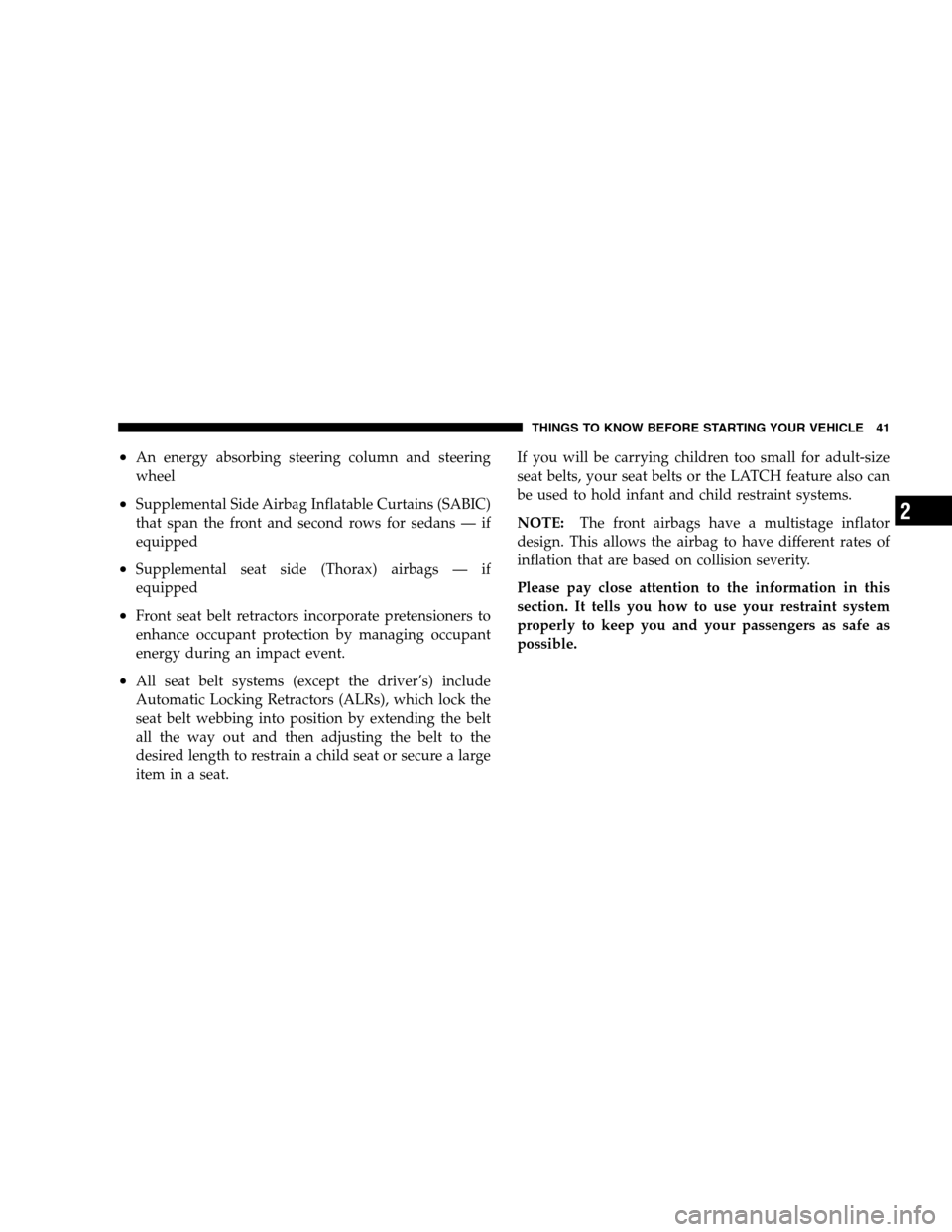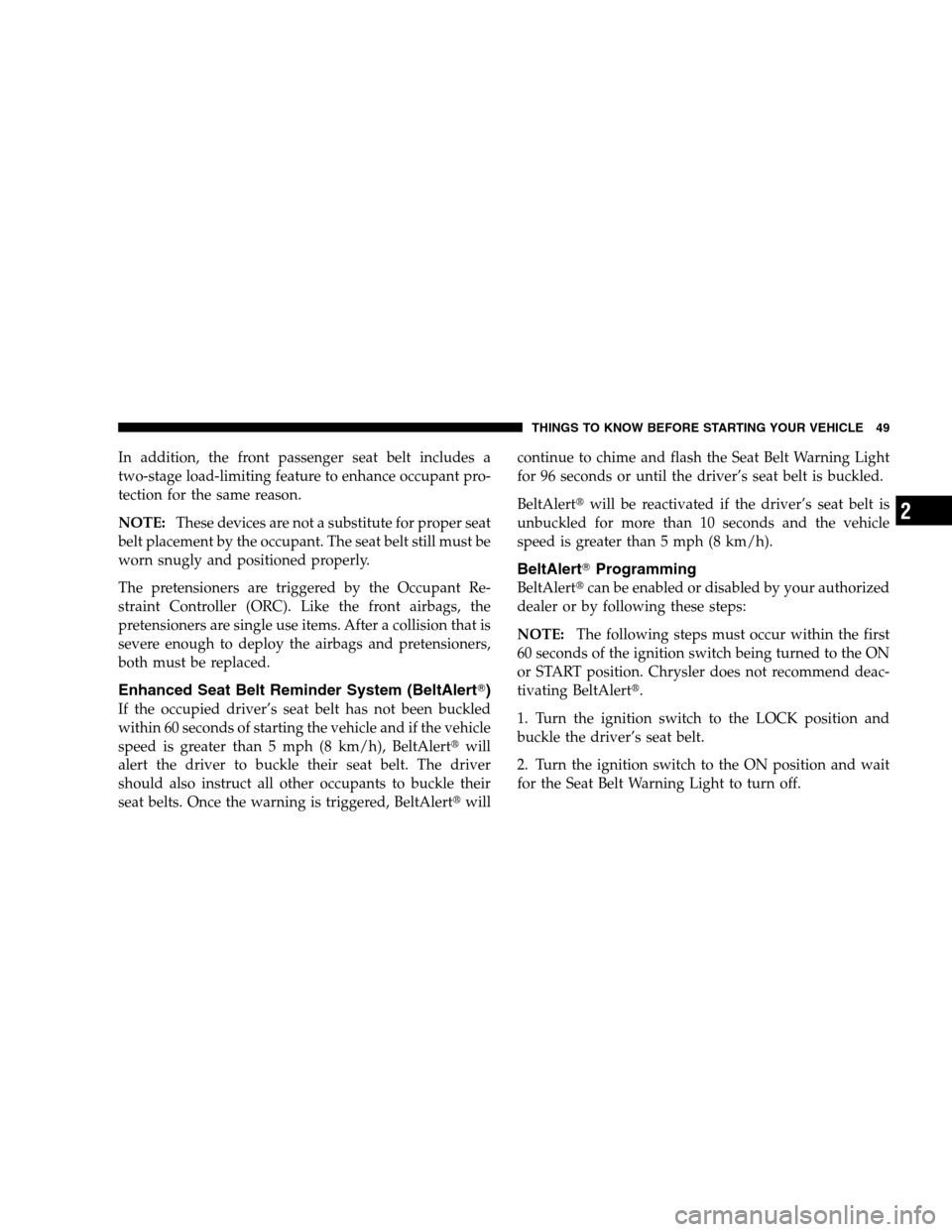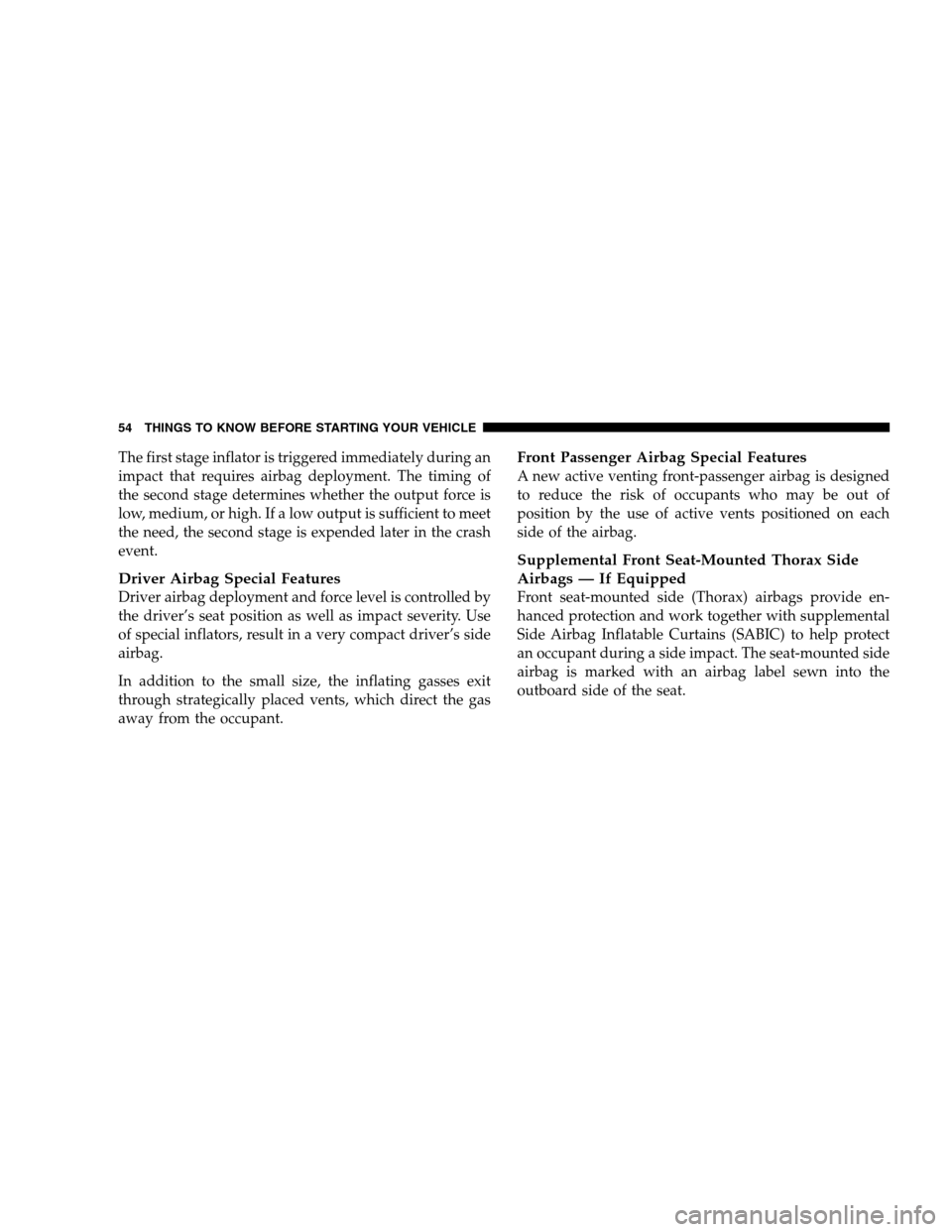Page 13 of 494
▫Rear Seat Belts........................48
▫Seat Belt Pretensioners...................48
▫Enhanced Seat Belt Reminder System
(BeltAlert�) ..........................49
▫BeltAlert�Programming.................49
▫Automatic Locking Mode................50
▫Seat Belts And Pregnant Women............51
▫Seat Belt Extender......................51
▫Supplemental Restraint System (SRS) - Airbag . .52
▫Airbag System Components...............53
▫Front Seat Airbag Features................53▫Airbag Deployment Sensors And Controls.....59
▫Event Data Recorder (EDR)...............65
▫Child Restraint........................67
�Engine Break-In Recommendations...........78
�SafetyTips ............................78
▫Exhaust Gas..........................78
▫Safety Checks You Should Make Inside
TheVehicle ..........................79
▫Periodic Safety Checks You Should Make
Outside The Vehicle....................80
THINGS TO KNOW BEFORE STARTING YOUR VEHICLE 11
2
Page 42 of 494
TRUNK INTERNAL EMERGENCY RELEASE
NOTE:As a security measure, a Trunk Internal Emer-
gency Release lever is built into the trunk latching
mechanism. In the event of an individual being lockedinside the trunk, the trunk can be simply opened by
pulling on the glow-in-the-dark handle attached to the
trunk latching mechanism.
OCCUPANT RESTRAINTS
Some of the most important safety features in your
vehicle are the restraint systems. The following safety
features are standard on all vehicles:
•Three-point lap and shoulder belts for all seating
positions
•Pretensioning and load-limiting retractors for the front
seat belts
•Advanced multistage driver and new active-vent front
passenger airbags
•New active-vent front passenger airbags
•Knee Bolsters for front seat occupants
Interior Trunk Emergency Release
40 THINGS TO KNOW BEFORE STARTING YOUR VEHICLE
Page 43 of 494

•An energy absorbing steering column and steering
wheel
•Supplemental Side Airbag Inflatable Curtains (SABIC)
that span the front and second rows for sedans — if
equipped
•Supplemental seat side (Thorax) airbags — if
equipped
•Front seat belt retractors incorporate pretensioners to
enhance occupant protection by managing occupant
energy during an impact event.
•All seat belt systems (except the driver’s) include
Automatic Locking Retractors (ALRs), which lock the
seat belt webbing into position by extending the belt
all the way out and then adjusting the belt to the
desired length to restrain a child seat or secure a large
item in a seat.If you will be carrying children too small for adult-size
seat belts, your seat belts or the LATCH feature also can
be used to hold infant and child restraint systems.
NOTE:The front airbags have a multistage inflator
design. This allows the airbag to have different rates of
inflation that are based on collision severity.
Please pay close attention to the information in this
section. It tells you how to use your restraint system
properly to keep you and your passengers as safe as
possible.
THINGS TO KNOW BEFORE STARTING YOUR VEHICLE 41
2
Page 51 of 494

In addition, the front passenger seat belt includes a
two-stage load-limiting feature to enhance occupant pro-
tection for the same reason.
NOTE:These devices are not a substitute for proper seat
belt placement by the occupant. The seat belt still must be
worn snugly and positioned properly.
The pretensioners are triggered by the Occupant Re-
straint Controller (ORC). Like the front airbags, the
pretensioners are single use items. After a collision that is
severe enough to deploy the airbags and pretensioners,
both must be replaced.
Enhanced Seat Belt Reminder System (BeltAlert�)
If the occupied driver’s seat belt has not been buckled
within 60 seconds of starting the vehicle and if the vehicle
speed is greater than 5 mph (8 km/h), BeltAlert�will
alert the driver to buckle their seat belt. The driver
should also instruct all other occupants to buckle their
seat belts. Once the warning is triggered, BeltAlert�willcontinue to chime and flash the Seat Belt Warning Light
for 96 seconds or until the driver’s seat belt is buckled.
BeltAlert�will be reactivated if the driver’s seat belt is
unbuckled for more than 10 seconds and the vehicle
speed is greater than 5 mph (8 km/h).
BeltAlert�Programming
BeltAlert�can be enabled or disabled by your authorized
dealer or by following these steps:
NOTE:The following steps must occur within the first
60 seconds of the ignition switch being turned to the ON
or START position. Chrysler does not recommend deac-
tivating BeltAlert�.
1. Turn the ignition switch to the LOCK position and
buckle the driver’s seat belt.
2. Turn the ignition switch to the ON position and wait
for the Seat Belt Warning Light to turn off.
THINGS TO KNOW BEFORE STARTING YOUR VEHICLE 49
2
Page 54 of 494
Supplemental Restraint System (SRS) - Airbag
This vehicle has airbags for both the driver and front
passenger as a supplement to the seat belt restraint
systems. The driver’s front airbag is mounted in the
center of the steering wheel. The passenger’s front airbag
is mounted in the instrument panel, above the glove
compartment. The words SRS AIRBAG are embossed on
the airbag covers.
NOTE:The front airbags are certified to the Federal
regulations that allow less forceful deployment.
The front airbags have a multistage inflator design. This
may allow the airbag to have different rates of inflation
that are based on collision severity and occupant size.
Front Airbag Components
52 THINGS TO KNOW BEFORE STARTING YOUR VEHICLE
Page 55 of 494

This vehicle may also be equipped with window bags to
protect the driver, front, and rear passengers sitting next
to a window. If the vehicle is equipped with window
bags, they are located above the side windows. Their
covers are also labeled SRS AIRBAG.
NOTE:Airbag covers may not be obvious in the interior
trim; but they will open to allow airbag deployment.
Airbag System Components
The airbag system consists of the following:
•Occupant Restraint Controller (ORC)
•Airbag Light
•Driver Airbag
•Front Passenger Airbag
•Supplemental Side Airbag Inflatable Curtains (SABIC)
— If Equipped
•Front Seat— side mounted (Thorax) Airbags — If
Equipped
•Front Impact Sensors
•Side Impact Sensors — If Equipped
•Steering Wheel and Column
•Instrument Panel
•Seat Belt Reminder Light
•Knee Impact Bolster
•Front Seat Belt Pretensioners
Front Seat Airbag Features
The front airbag system has dual-stage driver and front
passenger airbags. This system provides output appro-
priate to the level of crash severity as determined by the
Occupant Restraint Controller (ORC) and the impact
sensors at the front of the car.
THINGS TO KNOW BEFORE STARTING YOUR VEHICLE 53
2
Page 56 of 494

The first stage inflator is triggered immediately during an
impact that requires airbag deployment. The timing of
the second stage determines whether the output force is
low, medium, or high. If a low output is sufficient to meet
the need, the second stage is expended later in the crash
event.
Driver Airbag Special Features
Driver airbag deployment and force level is controlled by
the driver’s seat position as well as impact severity. Use
of special inflators, result in a very compact driver’s side
airbag.
In addition to the small size, the inflating gasses exit
through strategically placed vents, which direct the gas
away from the occupant.
Front Passenger Airbag Special Features
A new active venting front-passenger airbag is designed
to reduce the risk of occupants who may be out of
position by the use of active vents positioned on each
side of the airbag.
Supplemental Front Seat-Mounted Thorax Side
Airbags — If Equipped
Front seat-mounted side (Thorax) airbags provide en-
hanced protection and work together with supplemental
Side Airbag Inflatable Curtains (SABIC) to help protect
an occupant during a side impact. The seat-mounted side
airbag is marked with an airbag label sewn into the
outboard side of the seat.
54 THINGS TO KNOW BEFORE STARTING YOUR VEHICLE
Page 57 of 494
When the bag deploys, it opens the seam between the
front and side of the seat’s trim cover. Each bag deploys
independently, that is a left side impact deploys the left
bag only and a right-side impact deploys only the right
bag.
Supplemental Side Airbag Inflatable Curtain
(SABIC) — If Equipped
Supplemental Side Airbag Inflatable Curtain (SABIC)
Airbags offer side-impact protection to front and rear seat
outboard occupants in addition to that provided by the
body structure. Each airbag features inflated chambers
place adjacent to the head of each outboard occupant that
reduce the potential for side-impact head injuries. The
curtains deploy downward, covering both windows on
the impact side.
seat-mounted Side Airbag Label
THINGS TO KNOW BEFORE STARTING YOUR VEHICLE 55
2